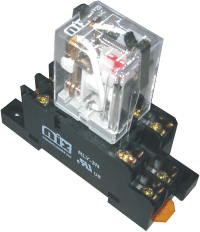gar
Senior Member
- Location
- Ann Arbor, Michigan
- Occupation
- EE
080501-1347 EST
George:
I assume by ice cube relay that you are talking about something like a Potter & Brumfield KUP series. The per contact rating for these relays is 10 A AC resistive with silver-cadmium-oxide contacts and 5 A AC with silver contacts.
I would doubt that these would be allowed as a branch circuit contactor. Surface paths are short and contact spacing is small.
If an inspector would approve a KUP controlling a branch circuit I would still consider it a poor choice.
I beat KUPs to death in a DC clutch control circuit. This is a 1 A load at 108 V DC. A very brutal application but it provides relatively fast drop-out time. The clutch has a lot of inductance and has a 500 to 1000 #-ft torque capability. We parallel the contacts and they are switched from a couple times to maybe 10 times per minute. This is in a machine that builds pinion preload on automotive axles. Life of the relays is 3 to 6 months. In this time a considerable conical mound builds on one contact and a mating cavity on the other from the DC.
Replacing these relays gives the electricians something to do associated with the machine. Otherwise we run for years with virtually no problems. In reality low failure rates are a problem because the electricians are lacking experience with the workings of the control.
.
George:
I assume by ice cube relay that you are talking about something like a Potter & Brumfield KUP series. The per contact rating for these relays is 10 A AC resistive with silver-cadmium-oxide contacts and 5 A AC with silver contacts.
I would doubt that these would be allowed as a branch circuit contactor. Surface paths are short and contact spacing is small.
If an inspector would approve a KUP controlling a branch circuit I would still consider it a poor choice.
I beat KUPs to death in a DC clutch control circuit. This is a 1 A load at 108 V DC. A very brutal application but it provides relatively fast drop-out time. The clutch has a lot of inductance and has a 500 to 1000 #-ft torque capability. We parallel the contacts and they are switched from a couple times to maybe 10 times per minute. This is in a machine that builds pinion preload on automotive axles. Life of the relays is 3 to 6 months. In this time a considerable conical mound builds on one contact and a mating cavity on the other from the DC.
Replacing these relays gives the electricians something to do associated with the machine. Otherwise we run for years with virtually no problems. In reality low failure rates are a problem because the electricians are lacking experience with the workings of the control.
.




